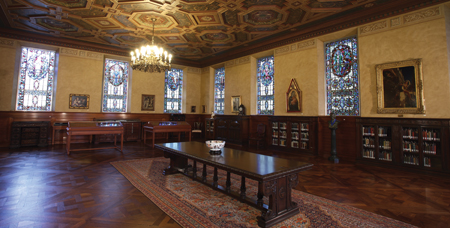1926 was an important year in the history of the Browning Collection. It was only one year after the London Times described the collection of Browning materials at Baylor the largest Browning Collection in the world, a distinction it has retained. In 1926 the Senior Class produced the “Browning Edition” of the University’s yearbook, dedicated to Dr. Andrew J. Armstrong, English Department Head from 1912 to 1952, and founder of the Browning Collection, which he gave to the University in 1918.
Because he is a Browning Scholar of world-wide fame, being “made up of an intensest life,” and having devoted that life to the spirt of Baylor and of Browning, with the result that they are synonymous in the minds of men at home and abroad.
And because he has given Baylor the Browning collection, a priceless pearl of truth and beauty, which will inspire in future generations to plunge, to strive, and to attain–
We, the Senior Class of 1926 , dedicate the Browning Edition of the Round-Up.”
The second and third pages of the Round-Up feature four poems about Robert Browning, including “Browning in Texas” by the British poet Edwin Markham, one of about forty poets that Dr. Armstrong ultimately brought to the campus.
Browning in Texas
Browning, your soul ranged over land and seas
Seeking this import of the march of man:
You were at home with folk of all degrees,
From Paracelsus down to Caliban.
But did you ever in your circling sweep
Behold this young dominion of mankind
Which for all coming centuries will keep
Tokens and trophies of your Orphic mind?
Texas! Did that name whisper in your brain
When you were searching life with peering eyes?
Ah, she is spacious as your song’s domain;
And like it, she is archt with starry skies.
Being great herself–wing-thrilled from every pole–
She folds in her own the greatness of your soul.
Excerpts from Robert Browning’s poetry are scattered throughout the yearbook, beginning with the Epilogue to Asolando:
“One who never turned his back but marched breast forward,
Never doubted clouds would break,
Never dreamed, though right was worsted, wrong would triumph,
Held we fall to rise, are baffled to fight better, sleep to wake.”
The above quote is followed by a photograph of the last formal portrait of Robert Browning, completed by his and Elizabeth’s only offspring Pen (Robert Barrett Browning) in May/June 1889. Shown just below the portrait is the sculpture “The Clasped Hands,” cast by the American sculptor, and Browning friend, Harriet Hosmer in 1853. Excerpts from other Robert Browning poems in the Round-Up include: “The year’s at the spring” from Pippa Passes, “The Guardian Angel,” “Rabbi ben Ezra,” “Love Among the Ruins,” “The Pied Piper of Hamelin,” the Invocation to his masterwork “The Ring and the Book,” dedicating the work to Elizabeth’s memory, “How They Brought the Good News from Ghent to Aix,” and “Paracelsus.” Included are photographs of the original three stained glass windows placed in The Browning Room at its completion in 1924 and moved to the Armstrong Browning Library & Museum in late 1951. The Library & Museum now has 62 stained glass windows.
If you get simple beauty and nought else,
You get about the best thing God invents.
R. Browning, A Death in the Desert








